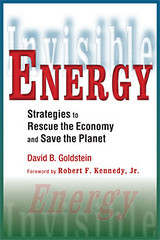Energy efficiency (including smart growth) is essential to economic recovery

Posted July 7, 2010 at 1:20PM
According to NRDC’s chief energy scientist David Goldstein, “the National Academy of Sciences, along with other scientific and business organizations, has estimated that efficiency could produce 30 percent of the energy America would otherwise need by 2030.” This would be the case, David points out, even if we limit efficiency options to those where the technology is already available and where the costs are lower than business as usual. Given current energy spending trends, that 30 percent savings could be worth an amazing $500 billion a year or so. Even better yet, David continues in a blog post, “the costs of efficiency investment pay themselves back on average in just three years.”
 Regular readers of this blog will be pleased to note that a not insubstantial portion of the projected savings could (and should) come from smart growth: In his new book Invisible Energy: Strategies to Save the Economy and Rescue the Planet, David cites research predicting that, if all new land development in the US were to adopt existing, proven smart growth features, consumers could collectively save as much as $2 trillion in transportation expenses over ten years. While an assumption that all development would be built to smart standards can best be described as heroic, even 40 percent of $2 trillion is still $400 billion, over a decade.
Regular readers of this blog will be pleased to note that a not insubstantial portion of the projected savings could (and should) come from smart growth: In his new book Invisible Energy: Strategies to Save the Economy and Rescue the Planet, David cites research predicting that, if all new land development in the US were to adopt existing, proven smart growth features, consumers could collectively save as much as $2 trillion in transportation expenses over ten years. While an assumption that all development would be built to smart standards can best be described as heroic, even 40 percent of $2 trillion is still $400 billion, over a decade.
Other keys include reforming utility regulation, encouraging renewable energy sources, reforming mortgage lending practices, and encouraging efficiency in buildings and consumer products. Invisible Energy’s publisher, Bay Tree Publishing, summarizes the book as follows:
“Offering effective tools for addressing the dual crises of climate change and the economy, Invisible Energy demonstrates the huge potential benefits of implementing energy efficiency technology and policies. This book shows how the two major challenges of our time are related, how market failures actually restrict competition, and how they impede the development of energy efficient products. Moreover, because no single trade association benefits from advocating for efficiency, the ‘hidden energy’ of efficient use is a forgotten resource both in comparison to green energy as well as polluting sources. This book shows how thoughtful policies, smart regulations, and new technologies can support a drastic reduction in greenhouse gas emissions while at the same time fostering greater economic growth, not less.”
 I won’t try to summarize Invisible Energy further but, fortunately, David has been blogging about the book and its message. I invite readers to check out his provocative posts, which include discussions of the following:
I won’t try to summarize Invisible Energy further but, fortunately, David has been blogging about the book and its message. I invite readers to check out his provocative posts, which include discussions of the following:
- How mortgage lending practices have actually encouraged defaults by failing to account for the combined household expenses related to mortgage debt, building energy, and transportation, all of which can be predicted with reasonable accuracy (David’s post here);
- Why energy efficiency could be a high-return investment justifying additional public spending (David’s post here); and
- Why attempting to discern whether the nation’s economy is now recovering (in which case we need to solve the problem of government deficits through austerity) or whether it is still faltering (in which case we need more economic stimulus) sets up a false choice (David’s post here).
David is one of NRDC’s most thoughtful and respected leaders. He asks questions that others don’t, and he supplies creative but immensely sensible answers. Fortunately for both the economy and the planet, his new book is full of them.
Move your cursor over the images for credit information.